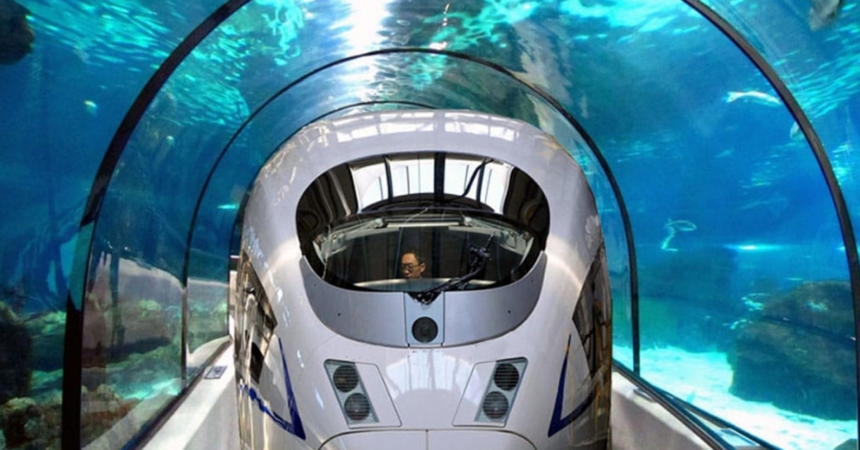An bold leap in transportation may quickly redefine the way you traverse continents. The UAE is embarking on a daring journey: establishing an underwater prepare to hyperlink Dubai with Mumbai. This is not nearly getting from level A to level B; it is about creating an immersive, awe-inspiring journey expertise beneath the ocean’s floor.
The proposed prepare will span an astonishing 1,200 miles, connecting two of the world’s most dynamic cities. At speeds starting from 600 to 1,000 km/h, this venture guarantees to revolutionize intercity journey, halving present journey occasions. “This isn’t nearly transport, however an immersive expertise,” defined Dr. Ahmed Al Hariri, head of the UAE’s Nationwide Advisor Bureau.
Initially teased in 2018, the underwater prepare is now poised to develop into a actuality. It would serve a twin objective, doubling as a conduit for water and oil transport. However the imaginative and prescient extends past mere practicality. Panoramic home windows will rework the underwater prepare right into a marine marvel, providing breathtaking views of oceanic life as passengers are whisked away at document speeds.
Sara Ahmed, a Dubai-based journey blogger, summed up the thrill: “The underwater prepare isn’t nearly getting from level A to B. It’s about relishing the wonders of the marine world. I can already see it being a significant draw for Dubai.”
The venture’s grandiosity invitations comparability with different bold undertakings, akin to Saudi Arabia’s NEOM. This $1 trillion initiative goals to construct a futuristic metropolis in concord with the pure setting. Nonetheless, if the UAE completes its underwater prepare earlier than NEOM’s unveiling, it may eclipse its rival’s audacious imaginative and prescient.
Each nations are recognized for pushing the boundaries of technological and infrastructural innovation. The Dubai-Mumbai prepare may very properly cement the UAE’s place as a frontrunner in futuristic design and world connectivity.
Mega-projects like these include hefty value tags and technical hurdles. From the immense price of development to engineering options for oceanic stress and passenger security, the challenges are important. However, the financial and tourism potential may outweigh these dangers, promising a considerable return on funding.
The venture may stimulate the UAE and India’s economies, fostering stronger ties between the 2 areas. It additionally provides a brand new dimension to tourism, providing vacationers a once-in-a-lifetime expertise beneath the waves.
Whereas the Channel Tunnel between the UK and France was groundbreaking in 1994, the Dubai-Mumbai prepare elevates the idea. Passengers will expertise greater than only a speedy journey; they’ll marvel on the vibrant marine life by the prepare’s clear partitions. Some have already nicknamed it the ‘Deep Blue Specific.’
Vacationers may discover this underwater journey a bucket-list journey. Nonetheless, issues stay about security and the potential psychological influence of touring deep underwater. Claustrophobia and thalassophobia would possibly deter some from embracing this futuristic journey possibility.
Rajesh Verma, a Mumbai-based entrepreneur, voiced his reservations: “I’ve all the time been cautious of the ocean’s depths. As a lot as I really like the thought, I’ll doubtless stick to standard modes of transport.”
Regardless of the challenges, the UAE’s bold prepare venture highlights the ability of human innovation. It’s a daring transfer to bridge not simply bodily distances but in addition cultural and financial divides. Whether or not the prepare materializes as deliberate or encounters setbacks, it has already captured the world’s creativeness.
In the long run, the success of this audacious endeavor will depend upon overcoming technical hurdles, securing public confidence, and guaranteeing monetary viability. But the thought alone is a clarion name for future prospects, proving that even the ocean’s huge depths might be conquered within the pursuit of progress.
Beijing to Kunming, China: Masking roughly 2,653 kilometers, this route connects Beijing with Kunming, providing journey occasions between 10 hours 43 minutes and 14 hours 54 minutes.
Beijing to Guangzhou, China: Spanning about 2,298 kilometers, this line hyperlinks Beijing to Guangzhou, considerably lowering journey time in comparison with typical trains.
Shanghai to Kunming, China: This route extends over 2,066 kilometers, connecting Shanghai with Kunming, facilitating environment friendly journey throughout jap and southwestern China.
Beijing to Shanghai, China: At roughly 1,318 kilometers, this line connects two of China’s main cities, Beijing and Shanghai, and is famous because the world’s longest high-speed line constructed in a single part.
Hangzhou to Shenzhen, China: This route covers round 1,495 kilometers, linking Hangzhou with Shenzhen, enhancing connectivity alongside China’s southeastern coast.
Qingdao to Yinchuan, China: Spanning about 1,762 kilometers, this line connects Qingdao to Yinchuan, facilitating journey between jap and northwestern China.
Beijing to Harbin, China: This route extends over roughly 1,700 kilometers, linking Beijing with Harbin, serving as an important connection to northeastern China.
Guangzhou to Kunming, China: Masking about 1,285 kilometers, this line connects Guangzhou with Kunming, enhancing journey between southern and southwestern China.
Tokyo to Hakata, Japan: This route spans roughly 1,174 kilometers, connecting Tokyo with Hakata, and is a part of Japan’s famend Shinkansen community.
Madrid to Barcelona, Spain: Masking about 621 kilometers, this line hyperlinks Madrid with Barcelona, considerably lowering journey time between Spain’s two largest cities.
The Seikan Tunnel in Japan is the world’s present longest undersea tunnel utilized by bullet trains. Spanning 53.85 kilometers (33.46 miles), it features a 23.3-kilometer (14.5-mile) part beneath the Tsugaru Strait, connecting Honshu and Hokkaido. Shinkansen bullet trains traverse this tunnel, which descends roughly 100 meters (330 ft) under the seabed and 240 meters (790 ft) under sea degree.
These high-speed rail routes exemplify developments in rail know-how, providing speedy and environment friendly transportation throughout huge distances.








